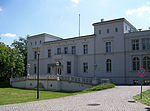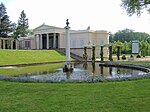Potsdam Pirschheide station

Potsdam Pirschheide station is a station on the Berlin outer ring. It was opened in 1958 as Potsdam Süd (south) station and was called Potsdam Hauptbahnhof (main station) from 1961 to 1993. In this period it was the most important station on the outer ring after Berlin Schönefeld Flughafen station. Although the station is far from the centre of Potsdam on the Pirschheide (Pirsch heath) to the southwest of the town, in its heyday as the main station it had substantial passenger traffic and often reached its capacity limit. With the reunification, however, the station rapidly lost importance and was almost completely closed except for a single platform in the lower part of the station. It is classified by Deutsche Bahn as a category 6 station.
Excerpt from the Wikipedia article Potsdam Pirschheide station (License: CC BY-SA 3.0, Authors, Images).Potsdam Pirschheide station
An der Pirschheide, Potsdam Westliche Vorstädte
Geographical coordinates (GPS) Address Nearby Places Show on map
Geographical coordinates (GPS)
| Latitude | Longitude |
|---|---|
| N 52.372777777778 ° | E 13.011111111111 ° |
Address
Potsdam Pirschheide
An der Pirschheide
14471 Potsdam, Westliche Vorstädte
Brandenburg, Germany
Open on Google Maps









